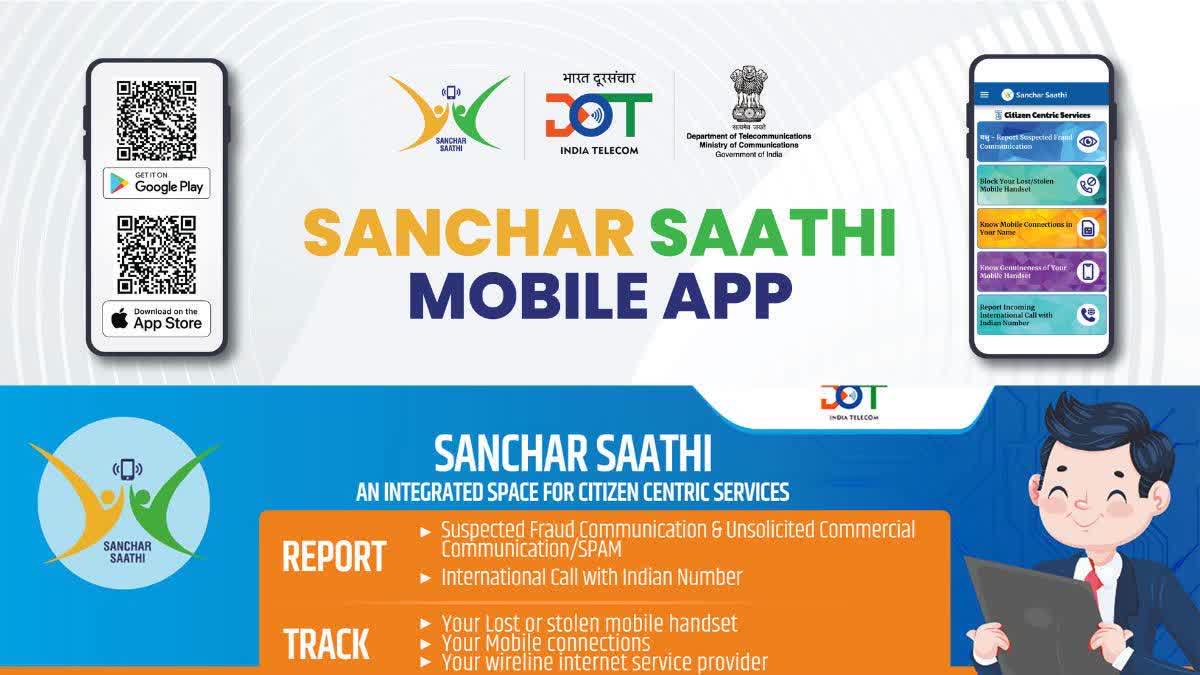New Delhi: In a landmark move to enhance telecom accessibility, security and empowerment across India, Union Minister of Communications, Jyotiraditya M. Scindia, unveiled a suite of citizen-focused initiatives aimed at transforming the nation’s telecom landscape.
The event, which showcased cutting-edge advancements, featured the launch of the Sanchar Saathi Mobile App, the National Broadband Mission (NBM) 2.0, and the inauguration of the Intra Circle Roaming (ICR) facility at Digital Bharat Nidhi (DBN) funded 4G mobile sites.
Sanchar Saathi Mobile App: Empowering Telecom Users
The Sanchar Saathi Mobile App is a user-friendly platform designed to enhance telecom security and empower citizens. Speaking at the launch, Scindia emphasised, “This initiative not only provides access to opportunities but also ensures a secure environment for all users.”
The app, available for both Android and iOS, offers critical tools to safeguard telecom resources and combat fraud. Its key features include:
- Chakshu: Reporting Suspected Fraud Communications. Users can report fraudulent calls and SMS directly from their mobile phone logs.
- Know Mobile Connections in Your Name: Citizens can monitor and manage all mobile connections issued in their name to prevent unauthorised usage.
- Blocking Lost or Stolen Mobile Handsets: The App enables users to block, trace and recover lost or stolen mobile devices.
- Verifying Mobile Handset Authenticity: A feature to check the genuineness of mobile handsets ensures consumers purchase legitimate devices.
With over 90 crore smartphone users in India, the App is poised to significantly curb telecom frauds and enhance the safety and trustworthiness of telecom networks nationwide.
National Broadband Mission 2.0: Driving Digital Inclusion
Building on the success of NBM 1.0, which established nearly 8 lakh telecom towers and increased broadband subscriptions from 66 crore to 94 crore, the Union Minister unveiled the National Broadband Mission 2.0 (NBM 2.0). The initiative aims to connect the remaining 1.7 lakh villages across the country and achieve ambitious digital milestones.
Scindia emphasised, “Our goal is to ensure that at least 60 out of every 100 rural households have access to broadband connectivity. We also aim for a minimum fixed broadband download speed of 100 Mbps, creating a robust digital infrastructure for rural India.”
Key objectives of NBM 2.0:
- Extending optical fiber cable (OFC) connectivity to 2.7 lakh villages by 2030, ensuring 95% uptime.
- Providing broadband access to 90% of anchor institutions like schools, healthcare centers, and panchayat offices.
- Increasing rural internet subscribers from 45 to 60 per 100 population by 2030.
- Powering 30 percent of mobile towers with sustainable energy by 2030.
- Facilitating 5G rollout nationwide and preparing infrastructure for 6G networks.
The mission aligns with PM Modi’s vision of a digitally inclusive and resilient India by 2047, fostering economic opportunities and improving access to education, healthcare and e-governance services.
Intra Circle Roaming (ICR) Facility: Bridging the Connectivity Gap
The inauguration of the Intra Circle Roaming (ICR) facility at DBN-funded 4G mobile sites marks another milestone in bridging the digital divide. The initiative allows subscribers of multiple telecom service providers (TSPs) to access 4G services from a single DBN-funded tower.
Scindia said, “This is a crucial pillar, with three TSPs, BSNL, Airtel and Reliance, joining forces to leverage each other’s infrastructure. With nearly 27,836 such sites, we are ensuring seamless connectivity and providing customers the freedom of choice.”
This innovation significantly reduces infrastructure costs while benefiting over 35,400 rural and remote villages. It ensures that subscribers in hard-to-reach areas experience uninterrupted 4G connectivity, enhancing digital empowerment across the nation.
Achievements of NBM 1.0
The successes of the first phase of the National Broadband Mission have set a strong foundation for NBM 2.0. Key accomplishments include:
- Expanding OFC networks to 41.91 lakh kilometers by September 2024.
- Increasing telecom towers to 8.17 lakh and broadband subscribers to 941 million.
- Resolving major Right of Way (RoW) issues through streamlined processes on the GatiShakti Sanchar Portal.
- Launching the Call Before u Dig (CBuD) mobile app to protect underground telecom infrastructure.
Sanchar Saathi Initiative: Combating Cybercrime
- The Sanchar Saathi Initiative, launched in May 2023, has made significant strides in tackling telecom fraud. It has achieved remarkable milestones, such as:
- Disconnecting 2.75 crore fraudulent mobile connections.
- Securing over 25 lakh lost or stolen devices.
- Freezing 11.6 lakh mule bank accounts to prevent financial fraud.
- Blocking 90 percent of spoofed calls in just two months through the International Incoming Spoofed Calls Prevention System.
These measures have safeguarded citizens from scams like fake arrests, tax frauds, and impersonation, reinforcing trust in India’s telecom networks.
Driving Economic Growth through Telecom Advancements
India’s telecom sector has become a cornerstone of the nation’s economic growth. The Union Minister highlighted that India facilitated 172 billion UPI transactions worth ₹247 lakh crore in 2024, powered by its robust telecom infrastructure. The mission to strengthen broadband connectivity will further drive e-governance, disaster management, and digital inclusion, laying the groundwork for a globally competitive India.
Future Aspirations: Towards a Digital India
Looking ahead, the Department of Telecommunications (DoT) is committed to bridging the digital divide and advancing India’s global digital standing. Initiatives like NBM 2.0, the Sanchar Saathi Mobile App, and ICR are not just about connectivity, they symbolize a vision of empowerment, inclusion, and innovation.
As Scindia aptly concluded, “These initiatives are not merely about infrastructure, they are about sowing the seeds for a digitally inclusive future where every citizen is empowered through connectivity and technology.”



